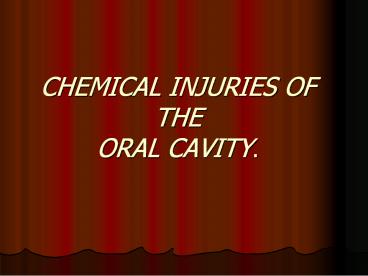CHEMICAL INJURIES OF THE ORAL CAVITY. - PowerPoint PPT Presentation
1 / 25
Title:
CHEMICAL INJURIES OF THE ORAL CAVITY.
Description:
ORAL CAVITY. CHEMICAL INJURIES OF ... Cancer chemotherapeutic agent Groups of drugs and agents, ... - No specific treatment for the oral lesions which although severe – PowerPoint PPT presentation
Number of Views:856
Avg rating:3.0/5.0
Title: CHEMICAL INJURIES OF THE ORAL CAVITY.
1
CHEMICAL INJURIES OF THE ORAL CAVITY.
2
CHEMICAL INJURIES OF THE ORAL CAVITY
- The oral cavity frequently manifests a serious
reaction to a wide variety of drugs and
chemicals. - The tissue reaction is that of a local response
to a severe irritant or even a caustic used
injudiciously.
3
Contd.
- Allergic phenomenon is the most common reactions
to drugs or chemicals. - The two main types that are of dental interest
are - 1.Drug allergy or stomatitis
- 2.Contact stomatitis
4
NONALLERGIC REACTION TO DRUGS AND CHEMICALS USED
LOCALLY.
- Irritants or caustics which are used by the
dentist in various therapeutic are technical
procedures induces a non allergic reactions when
used locally. - Some of these substances are discussed separately
below - 1.Aspirin (Acetylsalicylic Acid)
- 2.Endodontic Materials.
5
Contd.
- 2. Sodium Perborate.
- 3.Hydrogen Peroxide.
- 4. Phenol.
- 5.Silver Nitrate.
- 6. Trichloroacetic Acid.
- 7. Volatile Oils.
- 8. Miscellaneous Drugs and chemicals.
6
ASPIRIN (ACETYLASALICYLIC ACID)
- Uses
- It is especially used for the relief of
toothache. - Effects
- Particularly harmful to the oral mucosa if
applied locally. - Separation and sloughing of the epithelium and
frequently bleeding.
7
ASPIRIN BURNS
8
ASPIRIN BURNS
9
Endodontic materials
- Effects
- Dangerous to oral soft tissues.
- Damage or deep spread of inflammation and
necrosis if injected into hard tissues. - Examples
- Paraformaldehyde,sodium hypochlorite, hydrogen
peroxide etc.
10
Sodium Perborate
- Uses
- Used as a mouth-wash and in dentrifices.
- Effects
- Produced an erythema of the oral mucosa.
- Sloughing of the tissues.
11
Hydrogen peroxide
- Uses
- Prevention of periodontitis.
- Effects
- Epithelial necrosis.
- Sloughing of the epithelium.
12
PHENOL
- Uses
- Cavity sterilizing agent.
- Cauterizing agent.
- Effects
- Severe painful burns of the oral mucosa and skin.
13
DENTAL STAIN DUE TO LONG TERM USE OF
CHLORHEXIDINE MOUTHWASH
14
Volatile oils
- Effects
- Produce mild burns of the mucous membranes.
- Examples
- Oil of cloves.
- Oil of winter green.
- Eucalyptus oil.
15
TETRACYCLINE
- Effects
- Discoloration of deciduous or permanent teeth.
- Affinity for deposition in bones and tooth
substance. - Moffitts contributions
- Critical period for tetracycline induce
discoloration in the deciduous dentition is - 1. 4 months in utero.
- 2. 3 months in postpartum for maxillary and
mandibular incisor.
16
Contd..
- 3. 5 months in utero to 9 months postpartum for
maxillary and mandibular canines. - 4. 3 to 5 months postpartum is necessary for
permanent maxillary and mandibular incisor and
canines. - Grossmans contribution
- tetracycline therapy diminishes tooth
discoloration if its indicated in the pregnant
female or during 6 to 7 yrs of life.
17
TETRACYCLINE STAIN OF MANDIBULAR TEETH
18
MINOCYCLINE-ASSOCIATED PIGMENTATION
19
Contd..
- Clinical features
- Tetracycline
- 1. Yellowish or brownish-gray diffuse bands of
discoloration within the tooth structure. - 2. Fluoresces under ultra violet light.
- Chlorotetracycline
- 1. brownish gray colour within the tooth
structure.
20
Contd..
- Minocycline hydrochloride
- 1. commonly stained in skin, nails, sclera,
conjunctiva, thyroid, bones and teeth. - 2. dark colour of underlying bone through the
thin translucent oral mucosa. - 3. reveal varying patterns of discoloration.
21
Cancer chemotherapeutic agent
- Groups of drugs and agents, used for the
treatment of malignant neoplastic diseases. - Function
- - Destruction of malignant cells.
Cytotoxic agent exert their effect
preferentially against mitotic cells. - Side effect
- - Normal mitotic cells of oral mucosa,
bone marrow and skin are also prone to the
cytotoxic and damaging effect of these agents.
22
Contd..
- Clinical features
- - few general manifestations of these agents
due to their non specific nature - 1. Alopecia.
- 2. Stomatitis.
- 3. Radiation recall or radiation
sensitisation.
23
Contd..
- Oral manifestations
- 1. mucosal erosion and ulceration in the
mouth, frequently diffuse and multiple, often
related to neutropenia. - 2. haemorrhage resulting from
thrombocytopenia. - 3.hyper pigmentation of oral mucosa.
24
Contd..
- Treatment
- - No specific treatment for the oral lesions
which although severe, must be considered, of
only secondary importance to the patients major
problem.
25
THE END































